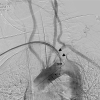Transradial Approach to Cerebral Aneurysm Occlusion in a Patient with an Aberrant Right Subclavian Artery: A Case Report
- PMID: 34172695
- PMCID: PMC8244373
- DOI: 10.12659/AJCR.931443
Transradial Approach to Cerebral Aneurysm Occlusion in a Patient with an Aberrant Right Subclavian Artery: A Case Report
Abstract
BACKGROUND Retroesophageal right subclavian artery, aberrant right subclavian artery, or lusoria artery constitutes an anatomical variation with a very low prevalence in the general population. Its presence in a patient does not add difficulty for cerebral arteries catheterization when a femoral approach is used, but may make the catheterization of cerebral vessels difficult when a right transradial approach is used. Unfortunately, this type of configuration of the artery is discovered after the decision to use the type of approach. CASE REPORT A 60-year-old woman with a diagnosed subarachnoid hemorrhage was studied with angiography through a transradial approach. A left carotid bifurcation aneurysm was diagnosed after three-vessel angiography was performed with a Simmons type 2 catheter, making a complete loop between the right subclavian artery, aortic arc, and left carotid artery. The ruptured cerebral aneurysm was completely occluded with 8 coils. The microcatheter used for the procedure emerged from the tip of an intermediate catheter located at the union of the vertical and horizontal segment of the petrous segment of the left carotid artery. CONCLUSIONS The presence of an aberrant right subclavian artery during cerebral angiography performed through a right transradial approach renders the treatment of a left carotid cerebral aneurysms more difficult but not impossible. Utilizing an appropriate intermediate catheter allows for stable navigation of the microcatheter and complete treatment of the aneurysm. This is the first report of cerebral aneurysm embolization through a right transradial approach in a patient with an aberrant right subclavian artery.
Conflict of interest statement
Figures






Similar articles
-
Left Transradial Neurointervention Using a 3-French Simmons Guiding Sheath for a Left Carotid Approach in Patients With an Aberrant Right Subclavian Artery: A Technical Note on a Case of Preoperative Embolization of Intracranial Meningioma.Cureus. 2025 Jan 24;17(1):e77944. doi: 10.7759/cureus.77944. eCollection 2025 Jan. Cureus. 2025. PMID: 39996182 Free PMC article.
-
Left Transradial Access Using a Radial-Specific Neurointerventional Guiding Sheath for Coil Embolization of Anterior Circulation Aneurysm Associated With the Aberrant Right Subclavian Artery: Technical Note and Literature Review.World Neurosurg. 2023 Oct;178:126-131. doi: 10.1016/j.wneu.2023.07.107. Epub 2023 Jul 26. World Neurosurg. 2023. PMID: 37506842 Review.
-
[Endovascular Treatment of a Ruptured Aneurysm of the Right Vertebral Artery with an Aberrant Right Subclavian Artery].No Shinkei Geka. 2020 Mar;48(3):223-229. doi: 10.11477/mf.1436204166. No Shinkei Geka. 2020. PMID: 32201391 Japanese.
-
Iatrogenic aortic dissection following transradial coronary angiography in a patient with an aberrant right subclavian artery.J Int Med Res. 2020 Aug;48(8):300060520943789. doi: 10.1177/0300060520943789. J Int Med Res. 2020. PMID: 32787591 Free PMC article.
-
Complex aortic arch anomaly: Right aortic arch with aberrant left subclavian artery, fenestrated proximal right and duplicated proximal left vertebral arteries-CT angiography findings and review of the literature.Neuroradiol J. 2015 Aug;28(4):396-403. doi: 10.1177/1971400915598075. Epub 2015 Aug 25. Neuroradiol J. 2015. PMID: 26306929 Free PMC article. Review.
Cited by
-
Transradial access of neuro-endovascular interventions with aberrant right subclavian arteries: Case series and literature review.Interv Neuroradiol. 2025 Jun 19:15910199251345110. doi: 10.1177/15910199251345110. Online ahead of print. Interv Neuroradiol. 2025. PMID: 40538177 Free PMC article.
-
Left Transradial Neurointervention Using a 3-French Simmons Guiding Sheath for a Left Carotid Approach in Patients With an Aberrant Right Subclavian Artery: A Technical Note on a Case of Preoperative Embolization of Intracranial Meningioma.Cureus. 2025 Jan 24;17(1):e77944. doi: 10.7759/cureus.77944. eCollection 2025 Jan. Cureus. 2025. PMID: 39996182 Free PMC article.
-
Transradial access for neurointerventional procedures: A practical approach.Brain Circ. 2023 Jun 30;9(2):88-93. doi: 10.4103/bc.bc_101_22. eCollection 2023 Apr-Jun. Brain Circ. 2023. PMID: 37576579 Free PMC article.
References
-
- Polednak AP. Prevalence of the aberrant right subclavian artery reported in a published systematic review of cadaveric studies: The impact of an outlier. Clin Anat. 2017;30(8):1024–28. - PubMed
-
- Scala C, Leone Roberti Maggiore U, Candiani M, et al. Aberrant right subclavian artery in fetuses with Down syndrome: A systematic review and meta-analysis. Ultrasound Obstet Gynecol. 2015;46(3):266–76. - PubMed
-
- Valsecchi O, Vassileva A, Musumeci G, et al. Failure of transradial approach during coronary interventions: anatomic considerations. Catheter Cardiovasc Interv. 2006;67(6):870–78. - PubMed
Publication types
MeSH terms
Supplementary concepts
LinkOut - more resources
Full Text Sources
Medical

